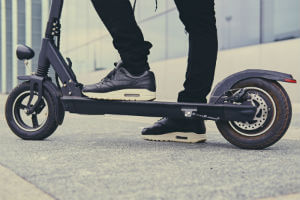 You are probably familiar with the brightly-painted scooters and bikes that are becoming popular throughout the valley. Here is what you should know about how they work, how they are treated under the law and safety issues.
You are probably familiar with the brightly-painted scooters and bikes that are becoming popular throughout the valley. Here is what you should know about how they work, how they are treated under the law and safety issues.
If you suffered an injury in an accident involving an e-scooter or bike, you can discuss it in a free consultation with a Scottsdale personal injury lawyer from our experienced law firm.
Electric scooters and bikes are gaining popularity with consumers all over the country. In Tempe, Mesa and Scottsdale, shareable e-scooters and bikes are available for rent. These eco-friendly vehicles are dockless, battery-powered and several companies offer them for short-term rent through apps on your smartphone.
The rental process is simple if you are at least 18 years old and download the appropriate app. You just scan your driver’s license into a smartphone app along with a credit card so that you can buy ride-credits. Once you select the vehicle you wish to rent, use your app to unlock it and then just ride away. When you are done with it, park it and use your app to lock it up. Sharable e-scooters and e-bikes costs about $1 to unlock and rental fees run about $0.15 per minute in many areas.
The companies that own the vehicles, Lyft, Lime, Razor, Bird, Spin, Jump and Uber pick them up each night, recharge them and deliver them where they will be most needed the next morning.
However, Arizona motor vehicle laws govern their safe and legal usage and some cities are regulating their use due to nuisance complaints and an increase in injuries.
Mopeds, scooters and electric bicycles are all treated differently under Arizona law.
| Type of Vehicle | License? | Registration? | Insurance? | Legal to ride on? |
| Mopeds | Driver’s license | Yes | Yes | Roads only |
| Electric,Gas-Powered Bicycles | No | No | No | Roads or bike paths |
| Gas-Powered Scooters | Motorcycle license | Yes | Yes | Roads only |
| Electric Scooters | No | No | No | Roads/bike paths |
There are various criteria used to classify each type of vehicle.
Legally, these are categorized as bicycles if their motors draw less than 750 watts and are operated at speeds of less than 20 mph. Electric bikes must be equipped with a manufacturer-installed label indicating the bike’s class, top-speed and wattage.
Class one and two electric bicycles can be operated on bicycle and multiuse paths. Class three electric bicycles cannot be ridden on these paths unless they are next to a highway or road or a local authority or agency allows it.
These are treated like bicycles under Arizona law if they have a 48cc engine or less and a top speed of 20 mph. Bikes that can exceed 20 mph may be considered mopeds or motorcycles
In Arizona, gas-powered scooters that generate over five horsepower are classified as regular motorcycles and unless they have a windshield, you must wear eye protection when riding one.
Under Arizona law, scooters with electric motors that weigh less than 75 pounds, have handlebars and cannot exceed 25 mph are treated like bicycles and e-bikes. No license, registration or insurance is required. That is one reason they are so popular.
Riding a stand-up scooter is much different than riding a bicycle and requires a different set of skills and coordination. Stand-up scooters can be wobbly and difficult to control. Even at their relatively slow speeds, crashes with pedestrians, other vehicles and stationary objects can result in serious injury, especially if the rider is not wearing a helmet.
According to a Consumer Reports investigation, there have been 1,500 injuries since 2017. One person died after crashing into a tree without a helmet. Consumer Reports also found eight people have died while riding a rentable e-scooter since the fall of 2017. One man died in March after crashing into a tree. Another died while riding after midnight and a child was killed after falling off the scooter he shared with his mother and was hit by another vehicle.
The American Journal of Otolaryngology (ear, nose and throat) published a study of scooter-related head and facial injuries, which found the most common injuries were closed-head injuries, including concussions and bleeding or bruising of the brain. The study found 66 percent of those injured in e-scooter accidents were not wearing a helmet.
Another safety issue exists because these new vehicles were not around when the streets and sidewalks they are being ridden on were designed and built. According to a survey conducted by Consumer Reports in March 2019, 51 percent of those who have ridden an e-scooter did so on a sidewalk, another 26 percent rode in a bike lane and 18 percent rode in the street.
There are several ways you can help reduce your risk of an accident when using one of these vehicles, including:
If someone else may have been to blame for your accident involving an e-scooter or e-bike, you can discuss the situation with one our licensed injury attorneys in Mesa. There is no obligation to take legal action if we determine you may have case.
Call us at 602-222-222 or fill out a Free Case Evaluation form.